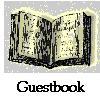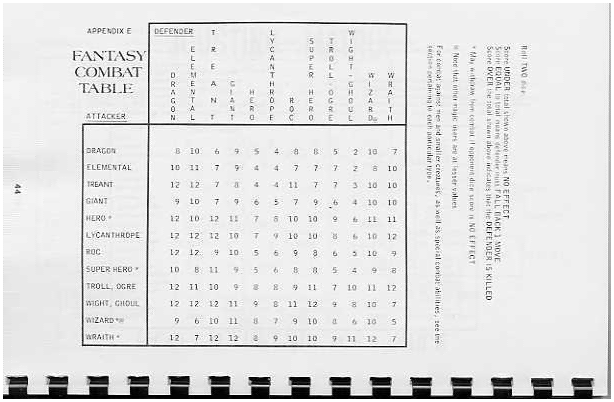I am fascinated by this matrix. I fantasize about playing miniatures campaigns with this matrix as the only combat resolution system, probably the only resolution system at all. You can imbed a ton of information into in a matrix like this, and you can easily manipulate the information in a bunch of ways.
This essay is speculative. If you're that kind of person, you can skip ahead to my report after actually using the matrix in play.
Building the Matrix
The matrix is a way for the designer to give each creature a dozen "stats" without the player having to remember anything but the creature's type. The stat for your Ogre is "Ogre" and its speed. Give every model a default speed of 6 inches, and Ogre has no in-play stats other than its name.
For example, you can set up three creatures in rock-paper-scissors configuration: A beats B, B beats C, and C beats A. Now none of those creatures is strictly better than the other.
You can differentiate offense and defense. Some creatures get good attack scores but bad defense scores. Some get the reverse. The rest are about equally good at attack and defense.
With points for each model, you have another way of balancing things. Creatures can be weak individually but efficient. When you figure out whether A beats B, you need to specify "N points worth of A" versus "N points worth of B."
Designing Models to Use the Matrix
On the other end, there are creative ways to use the matrix.
You can give creatures bonuses. Say that a werewolf uses the lycanthrope line, but a weretiger uses the lycanthrope line with a +1 bonus. A wererat would be lycanthrope -1.
You can give creatures double strength: The super-lycanthrope attacks as two lycanthropes.
You can give creatures double-duty. A mighty werewolf might be a hero-lycanthrope. He fights as either creature, depending on who gives better odds.
You can give a creatures super-double-duty: The super-lycanthrope/hero attacks as a lycanthrope plus as a hero.
You can give creatures different attack and defense tables, such as a creature that attacks like a giant but only defends like a lycanthrope.
This one, simple table gives you a hundred permutations and half-a-dozen ways to permute those permutations. Even given the strict interpretation that one will use only this table for resolution, you have a marvelously rich potential for solid design and rewarding play.
Special Attacks
Heroes with bows could attack at range, but with a "push back" becoming "no effect." Maybe there should be a -1 penalty on top of that. Or instead of.
Wizards could attack at a distance. They could also have area-effect spells that attack everyone in the area as an elemental, and maybe the "arcane hammer" spell that attacks one target as a giant. Other spells would have non-lethal effects, such as push-backs or paralysis. You'd use the matrix for "saving throws," though it's probably the wizard rolling an attack rather than the defender rolling a defense.
Dragons could have an elemental attack, too, representing their breath weaponry. Big dragons would attack everyone in their breath area with two or three elemental attacks, or an elemental attack with a bonus.
Other Special Features
You can give creatures special abilities to make them stronger or weaker without referring to the matrix.
Crazed Giant: fights as a Giant but must charge the nearest enemy whenever given the opportunity.
Silver Crescent Werewolf: fights as a Lycanthrope but has the hero's disengage feature.
Life-stealing Ghoul: gets +1 on attack and defense for each creatures it's killed.
Damage
As an optional rule, when a model is forced back (on an attack roll that matches but doesn't exceed the matrix number), the model is wounded. Each time a model is wounded, it gets a cumulative -1 on its attack rolls, and enemies' target numbers also go down by 1. Now models can get beat up and weakened instead of just eliminated.
Does that just make the game more complicated? Maybe, but it's satisfying to have a state between A-OK and dead. The rule also makes certain funky abilities easier to define:
Brittle Golem: Fights as a Giant, but it suffers 1 damage each time it attacks (after the attack resolves).
Battle Priest: Fights as a Hero 1. At the end of the Battle Priest's turn, each wounded, allied model in contact with the Battle Priest heals 1 damage.
Troll: Fights as a Giant. At the start of its turn, heal all damage on the Troll.
A Closer Look
Would the matrix live up to my fantasies? I doubt it. A closer look reveals some flaws. There's no description or point cost for the wraith. True trolls have their own defense column described in their write-up, violating the purity of using this matrix for all resolution. Likewise, elves with magic items can kill some fantastic creatures (but only some), so they have their own attack row in their description. Some creatures' special abilities, such as the wights' paralysis, don't come into play in fantasy combat; they only work against normal troops.
The Rest of the Game
The fantasy combat matrix is merely an addendum to the original Chainmail game. All these creatures also had "stats" to resolve combat with regular troops. The system for regular versus fantasy troops, however, isn't inspiring. I don't see any reason to use regular old soldiers when you can stage battles between cool monsters.
The game also had a morale system that's pretty complicated. Here's what I'd replace it with: When a model is pushed back, it might become demoralized. Have the pushed back model make a roll as if attacking the model that pushed it back. If the model succeeds, its morale is not broken. With this system, the relative power of the two models determines how likely a model is to route. Finally some models would be fearless, never routing.
The Matrix as an Artifact of an Earlier Age
This matrix comes from a time when characters did not yet have stats (measurements), they had natures (types). Once D&D was published, creatures came to have stats. Giants had attack ratings and dragons had defense ratings, and you used those numbers to determine whether the giant killed the dragon. But when playing with this matrix, giants and dragons don't have attack and defense numbers. They have natures, and this table reflects their respective natures. Would Foucault say that the matrix represents the medieval way of knowing while D&D-style stats represents the modern way of knowing?
—JoT
November, December 2001, December 2002
Report on the Matrix in Practice (VCon 2002)
Ben
This Matrix
This matrix comes from the original Chainmail miniatures game, ca. 1973. The game contained a "fantasy supplement" in what was otherwise an historical simulation game.
This matrix determined whether one creature's attack killed another. If you beat the number on 2 dice, you killed your opponent. If you tied, you pushed the opponent back. If you rolled under, you had no effect.
The original D&D books referred to this table and said that one could use it as an alternative combat system, with a success counting as a hit (for a die of damage). Characters were rated by class and level as to how they fit on the table, with 4th-level fighters being "heroes" and 8th-level fighters "superheroes." Third-level fighters fought as "Hero 1."
Note how the Treant (living tree) is not in alphabetical order. It's between Elemental and Giant. Those who know the treant's original, Tolkiensque name know why it's misalphabetized. But why didn't they invent a new neame between Elemental and Giant, such as "Forest Guardian" or maybe "Forent"?
top |
















